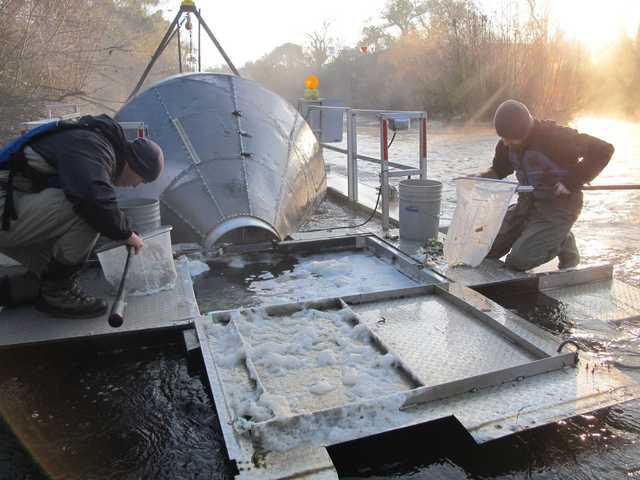Research aimed at boosting the population of threatened fish as well as assuring future water deliveries for South County farms and cities continues on the Stanislaus River.
The stakes of the research financed by the South San Joaquin Irrigation District and Oakdale Irrigation District are high. And they aren’t just limited to the Stanislaus River watershed. Research being conducted by the highly regarded FISHBIO firm with a worldwide reputation for fishery restoration that’s being funded by the two districts to the tune of $1 million a year will also benefit the future of the Tuolumne and Merced watersheds.
The stakes include:
uThe future survival of Chinook salmon and steelhead fish.
uThe potential of not being able to farm 132,000 acres now irrigated in the Northern San Joaquin Valley.
u120,000 acre feet of water SSJID and OID customers including the cities of Manteca, Tracy, and Lathrop could forfeit in a normal year with significantly larger cutbacks during drought years.
uIncreased groundwater pumping of 1.57 million acre feet of water annually by cities and farmers.
uAn annual economic loss of $12.9 billion to the combined economy of San Joaquin, Stanislaus, and Merced counties.
uSome $10 million OID and SSJID would lose annually from hydroelectric generation.
uThe loss of 4,000 jobs in the region.
uBased on historic hydrology on the Stanislaus River Basin, New Melones Reservoir — the state’s fourth largest at 2.4 million acre feet of water — could go dry 12 times every 95 years.
All of that is based on a state plan announced on Sept. 15, 2016 to commander more than 300,000 acre feet of water from the three rivers in a bid to boost salmon/steelhead population by what state experts project would be a net gain of 1,100 fish combined on the Stanislaus, Merced, and Tuolumne.
SSJID General Manager Peter Rietkerk said the goal is to provide data that the state’s plan to simply throw more water at the problem of native fish survivability is not the most effective way to go about making gains to protect fish. At the same time the state proposal would unnecessarily devastate the 209 regional economy.
“Research is pointing to non-native predators and other issues that are a bigger factor than increased water releases the state (is suggesting),” Rietkerk said.
Rietkerk noted the goal is to use science to best help the fish population. That likely means restoration of more spawning areas such as OID’s project at Honolulu Bar as well as addressed predation on the Stanislaus River.
He added water temperatures and other issues are proving to be more critical and effective than just flushing the river with more water in the early part of the year as the state plan calls for.
FISHBIO — at the request of OID and SSJID that have continuously picked up the tab — started research and monitoring on the Stanislaus River in 1993.
It is the most comprehensive and longest running salmon and steelhead monitoring program in San Joaquin River Basin. The ongoing monitoring activities track the abundance, distribution, migration characteristics, and habitat use of salmon and steelhead trout. The project also seeks to determine the effects of reservoir operations and the highly altered channel geometry — gravel extraction, levee construction, and woody debris removal — on the fish and wildlife populations in the Lower Stanislaus River.
To contact Dennis Wyatt, email dwyatt@mantecabulletin.com
FISHING FOR ANSWERS
SSJID funds research aiming to boost salmon population



